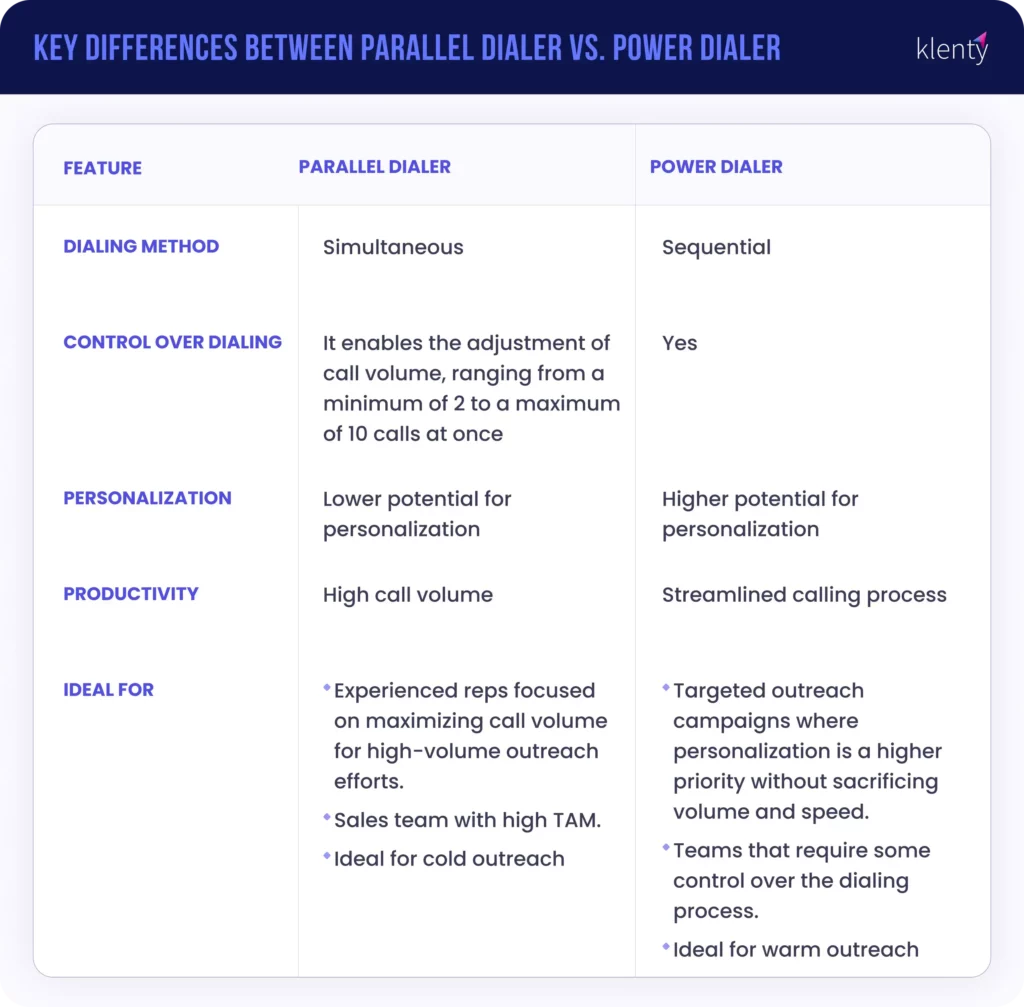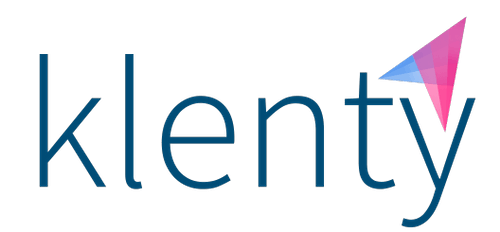With the sheer volume of calls you need to make in a day, automating your outbound calling is a no-brainer.
But choosing the right dialer software is crucial as it significantly impacts your outreach efficiency and productivity.
Parallel Dialer and Power Dialer are the two popular options to automate and scale your outbound calling efforts.
In this blog, we'll dissect their features, advantages, and drawbacks to help you make an informed decision about which one is the best fit for your needs. Let's get started!
What Is a Parallel Dialer?
A parallel dialer automatically dials a fixed number of prospects from your list simultaneously. This helps you avoid the time wasted on unanswered calls, voicemails, and busy lines.
Let’s take a closer look at the pros and cons of using a parallel dialer.
Advantages of a Parallel Dialer
1. Increased call volume and improved connect rates
A parallel dialer allows you to make 300 to 350 calls an hour, enabling you to reach more prospects in less time.
This increases your chances of connecting with more prospects and initiating meaningful conversations.
2. Reduced idle time for reps
With a parallel dialer, you can eliminate time wasted on punching numbers, unanswered calls, admin work of clicking, and data entry.
This enables you to maintain focus solely on engaging prospects.
3. Scalability
As your business expands, the necessity for enhancing your outreach efforts grows in tandem.
Parallel dialers are instrumental in meeting this demand by facilitating effective outreach, enabling you to ramp up call volumes seamlessly as your business grows.
Disadvantages of a Parallel Dialer
1. Not ideal for new sales reps
The relentless dialing pressure of parallel dialers can be daunting for new reps. Under this pressure, new reps may struggle to maintain their composure and deliver well-crafted pitches.
They might rush through calls, making them seem impersonal and pushy, sacrificing call quality in an attempt to keep up with the dialing pace. This can leave prospects frustrated and uninterested.
2. Not ideal for high-ACV deals
High ACV deals require a slower and more deliberate approach to ensure that each interaction is tailored to the prospect's needs and priorities.
Parallel dialing, by its nature, prioritizes increasing call volumes, which may not align with the strategic focus required for high ACV deals.
3. Limited Total Addressable Market
If your Total Addressable Market (TAM) is smaller, you would want to build relationships, nurture accounts, and multithread deals. In a limited TAM, every prospect interaction is valuable, unlike in a larger market where you might have the luxury of quickly moving on to the next prospect if one doesn't pan out.
In this scenario, using a parallel dialer means you're potentially contacting multiple leads at once, which can quickly burn through your list, leaving you with no one else to reach out to.
4. Not suitable for sales teams with unclear value proposition
A parallel dialer is not ideal for sales teams that have yet to determine their product market fit, common objections, and value propositions.
Given that you're in the midst of learning and refining your approach, it's important to prioritize quality over quantity in your sales efforts. Each conversation you have holds significant value, so it's beneficial for you to take a slower, more deliberate approach to sales.
5. Not suitable for engaged deals
Engaged prospects are further along in the buyer's journey and may have a higher intent to purchase. Unlike cold prospects, they expect tailored solutions and value relationships built on trust and rapport.
A generic or mass outreach approach, such as using a parallel dialer to make simultaneous calls, may come across as impersonal and could undermine the relationship.
Which Kind of Sales Teams Can Use a Parallel Dialer?
Sales teams with experienced reps who prioritize high call volumes, target homogeneous lists of prospects, or run time-sensitive campaigns can enhance their outreach efforts by leveraging parallel dialers' capabilities.
Why teams with experienced reps? Since parallel dialers focus on speed, seasoned reps can handle multiple calls simultaneously without sacrificing the quality of their pitch. Their extensive knowledge of the solution and its value proposition allows them to tackle objections confidently and effectively, making it easier to navigate multiple conversations at once.
Let’s take a closer look at how you can leverage parallel dialers effectively for each goal:
1. Maximize call volume
A parallel dialer is ideal for teams operating in highly competitive industries or those targeting a large pool of potential customers.
By efficiently managing multiple conversations simultaneously, you can significantly boost your productivity and increase the chances of connecting with the prospect and ultimately booking more meetings.
2. Target a homogenous list of prospects
Parallel dialers work best when sales teams have a uniform or homogeneous list of prospects. This means the leads share similar characteristics, such as industry, company size, or geographic location.
With a parallel dialer, you can efficiently navigate through these prospects, leveraging your knowledge of the target audience to tailor your pitch effectively.
3. Suitable for initial outreach for industries with large total addressable market (TAM)
With a large TAM, manually dialing each lead and qualifying them is extremely time-consuming.
A parallel dialer facilitates quick conversations with multiple prospects, allowing you to gather essential information and assess their interest in your offer. This lets you filter out unqualified leads, saving you time and resources.
What Is a Power Dialer?
A power dialer automatically dials phone numbers from a pre-loaded contact list. You can upload a list of prospects into the dialer system, which will sequentially dial each number without any manual intervention from your side.
The dialer can detect when a call is answered by a live person, reaches voicemail, encounters a busy signal, or if the call gets disconnected. Based on these call outcomes, the dialer automatically rings the next number in the list or leaves a pre-recorded voicemail.
If needed, you can pause between calls to take notes or prepare for an upcoming call.
Advantages of Power Dialer
1. Control over dialing
Power dialers allow sales reps to control the pacing of calls, ensuring they have enough time between conversations to make notes, review information, and prepare for the next call.
2. Scope for personalization
With a power dialer, sales reps can personalize each call based on the prospect's information before dialing, potentially increasing the chances of a successful conversation.
3. Ease of Use
Power dialers are often more straightforward to set up and use compared to parallel dialers, making them more accessible for smaller sales teams or individual sales reps.
Disadvantage of Power Dialer
1. Lower Call Volume
Compared to parallel dialers, power dialers typically have a lower call volume since they only dial one number at a time. This can result in fewer connect rates within a given time frame.
Which Kind of Sales Teams Can Use a Power Dialer?
Here's a breakdown of the types of sales teams that can benefit from using a power dialer:
1. Targeted outreach campaigns
Sales teams focusing on targeted outreach campaigns with a degree of personalization can use a power dialer effectively.
With Power dialers, sales reps can place calls automatically and have immediate access to specific details from CRM about the prospects who attend the call, allowing them to tailor their pitches.
This way, you maximize the number of calls made without sacrificing the quality of your conversation.
2. Teams that require some control over the dialing process.
Compared to parallel dialers, power dialers offer a significantly higher level of control over the speed of dialing. They call only one prospect at a time and place the next call automatically only after the previous call ends.
This allows you to be more prepared for the next call and continue dialing without being overwhelmed by the call volumes.
3. Teams who are comfortable with click-to-call dialing
Power dialers are efficient if you’re already experienced in using a click-to-call dialer and are looking to scale outreach but are not ready to match the pace of parallel dialing yet.
The dialer strikes a balance between parallel dialing and click-to-call dialing. It offers you the speed and control you need over dialing.
This means you can reach more prospects in less time with effective messaging that resonates with your prospects.
Key Differences Between Parallel Dialer vs. Power Dialer
A parallel dialer and a power dialer are both tools used in sales to streamline the process of making outbound calls. While they share similarities in functionality, they have distinct differences in their approach and capabilities.
Let’s understand the key differences between parallel dialers and power dialers through a comprehensive table below:

Legal Compliance for Parallel and Power Dialers
It's essential for sales teams using both Parallel and Power Dialers to ensure compliance with relevant regulations, such as the Telephone Consumer Protection Act (TCPA) in the United States, to avoid potential legal issues related to unsolicited calls and consumer privacy.
Which Is the Best Dialer for You?
Truth be told, there is no one-size-fits-all dialer. You need to change your dialing mode depending on the type of your outreach.
- If you want to increase your call volumes per day, you need a parallel dialer.
- If your aim is to make high-volume outbound calls with a degree of personalization, you need a power dialer.
- You need a click-to-call dialer if you want to engage high-ticket prospects or make warm calls with complete personalization.
What you truly need is the flexibility to switch between different dialing modes within the same tool with just a click as your calling context changes.
Moreover, your dialing solution should seamlessly integrate with your CRM, spreadsheets, and other cold calling tools in your tech stack. It should also include built-in features like call recording, transcription, and automatic voicemail drop to free you from administrative tasks, so you can focus more on engaging prospects.
But is there a tool that gives you all this?
Yes, this is where Klenty’s Sales Dialer stands out as a comprehensive solution.
Why Is Klenty Your Best Choice?
Klenty is the only sales engagement platform that offers three different dialing modes—Parallel, Power, and Click-to-Call dialing—in a single platform.
Here’s how you can use Klenty’s Sales Dialer to maximize your call volume with precision:
- Sales reps with a high volume of calls can use the Parallel Dialer to save time by dialing up to 5 prospects at a time.
- Alternatively, for reps who prefer structured call schedules without interruptions, the Power Dialer offers a focused environment dedicated solely to their calls. This enables you to focus more on building rapport and having meaningful conversations with the prospects.
- For reps using a multi-channel strategy and making warm calls, the 1 Click-to-Call Dialer can be helpful as it provides prospect information from the CRM or cold calling software before each call, facilitating personalized conversations and boosting conversion rates.
And this does not end here. Here are some more features of Klenty’s Sales Dialer that help you boost your outreach:
- Seamless CRM integration: Klenty integrates with 5 CRMs: Salesforce, MS Dynamics 365, HubSpot, Zoho, and Pipedrive. Effortlessly sync all calling activities, notes, and tasks in your CRM.
- Conversation Intelligence: Let AI handle note-taking during calls. Quickly review calls with auto-summarization and effortlessly sync notes to your CRM.
- Voicemail Drop: Send tailored, pre-recorded voicemails with just one click.
- Local Presence Dialing: Reach prospects using their area code and establish a global local presence.
- Call Recording: Review calls at your convenience.
- Call Reports: Measure performance and identify areas for improvement with comprehensive call analytics.
- Call Outcome: You can mark the status of each call instantly for a streamlined follow-up.
FAQs
What is the difference between a power dialer and a Parallel dialer?
- Parallel dialers automatically dial a list of phone numbers and can deliver pre-recorded messages or connect answered calls to reps. They can dial multiple numbers simultaneously, making them suitable for high-volume calling.
- On the other hand, power dialers dial one number at a time per rep, giving them more control over each call. Power dialers are commonly used in sales environments where reps must personalize their approach to each call.
What are the types of dialers?
- Manual Dialers: Requires you to dial numbers manually.
- Power Dialers: Automatically dials after you finish a call.
- Progressive Dialers: Dials automatically, connecting reps only to answered calls.
- Parallel Dialers: Dials multiple numbers at once.
- Predictive Dialers: Uses algorithms to predict rep availability and dials accordingly.

